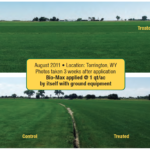For as many ways as there is to cook a potato, there are just as many ways to grow them. Farmers who focus on the fresh market have cropping targets that include bakers, boilers/steamers and the relative newcomer, fingerlings. Those who target the processors grow potatoes for French fries, as well as spuds that will be scalloped, sliced and dehydrated (aka buds, which will be used for mashed potatoes and other intensely processed potato products for restaurants, institutional use and households). Then there are the potatoes strictly grown for seed. Each category can then be divided into two more: conventional and organic.
Each target market has its own version of what the right potato looks like. In the fresh market category, marketability is very dependent on potatoes that have the right size and grade. The bakers must have a clean interior quality as exemplified by appropriate flesh color, flesh texture, lack of internal discoloration, no hollow heart, and appropriate skin texture and skin set.
The boiler/steamer category is similar to that of the bakers, but these spuds tend to have thinner, more sensitive skins that need to be protected. Every grower must produce potatoes with a good skin set and the right skin color particular to the variety of potato. Size is also very important, and it must match with how the consumer cooks and eats the potato. All the fresh market potatoes need to be able to be stored for a reasonable length of time. They also need to have appropriate flavor to go with the texture of the flesh.
In the processor category, growers need to be mindful of the processor’s specific size and grade requirements. Growers who do not meet these size and grade requirements may be penalized by the processor, but the farmers who meet and go above these specifics can earn premiums. These details include specific gravity or density of the potato, clean internal quality, appropriate sugar levels, and storability. In some cases, flesh color is also important.
Seed potatoes have key quality requirements as well. This category centers on the tuber size, tuber shape, energy or carbohydrate levels in the tuber, and the number and location of eyes on the tuber. Regardless of where a grower’s potatoes end up, the appropriate qualities can be directly and positively impacted by Science-Driven, Five-R nutrition.
Conventional potato crops require specific applications.
- Rosette: Apply Sysstem® Leaf Max at 2 to 3 quarts per acre.
- Row close: Apply Sysstem® Leaf Max at 2 to 3 quarts per acre a second time.
- Tuber bulking/heat stress: Apply UltraFinish® Potassium at 1 gallon per acre.
- Vine preservation and extension for best crop finish: Apply MicroMix DL® at 2 quarts per acre and repeat the application if needed.
Organic potato crops follow a similar application timetable but require different products and solutions.
- Rosette: Apply CLEAN Micro-Mix® at 3 quarts per acre.
- Row close: Do a second application of CLEAN Micro-Mix® at 3 quarts per acre.
- Tuber bulking/heat stress: Apply CLEAN Potassium 0-0-6® at 1 gallon per acre, and this application occurs at tuber bulking and summer heat. Growers must repeat this application a second time 7-14 days after the first. This will be the fourth application.
- Vine preservation and extension for best crop finish: Apply CLEAN Micro-Mix® at 2 quarts per acre and repeat the application 7-14 days later.








